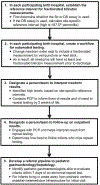Newborn Screening for Biliary Atresia: a Review of Current Methods
- PMID: 34817690
- PMCID: PMC8651301
- DOI: 10.1007/s11894-021-00825-2
Newborn Screening for Biliary Atresia: a Review of Current Methods
Abstract
Purpose of review: Biliary atresia is a serious neonatal liver disease due to obstructed bile ducts that has better outcomes when detected and treated in the first 30-45 days of life. This review examines different methods to screen newborns for biliary atresia as well as discusses observations from ongoing screening programs implemented in parts of the United States.
Recent findings: Screening strategies for biliary atresia include detecting persistent jaundice, examining stool color, testing fractionated bilirubin levels, or measuring bile acid levels from dried blood spot cards. The stool color card program is the most widely used screening strategy worldwide. An alternative approach under investigation in the United States measures fractionated bilirubin levels, which are abnormal in newborns with biliary atresia. Fractionated bilirubin screening programs require laboratories to derive reference ranges, nurseries to implement universal testing, and healthcare systems to develop infrastructure that identifies and acts upon abnormal results. Biliary atresia meets the disease-specific criteria for newborn screening. Current studies focus on developing a strategy which also meets all test-specific criteria. Such a strategy, if implemented uniformly, has the potential to accelerate treatment and reduce biliary atresia's large liver transplant burden.
Keywords: Bile acids; Conjugated bilirubin; Direct bilirubin; Jaundice; Pale stools; Stool color card.
© 2021. The Author(s), under exclusive licence to Springer Science+Business Media, LLC, part of Springer Nature.
Conflict of interest statement
Conflicts of interest/Competing interests: SH is on a Data Safety Monitoring Board coordinated by Syneos Health, for a clinical trial that tests a therapy for biliary atresia.
Figures


References
-
- Wilson JMG J G. Principles and Practice of Screening for Disease. WHO Public Paper 34.; 1968. Accessed June 23, 2021. https://apps.who.int/iris/bitstream/handle/10665/37650/WHO_PHP_34.pdf.
-
- Mowat AP, Davidson LL, Dick MC. Earlier identification of biliary atresia and hepatobiliary disease: Selective screening in the third week of life. Arch Dis Child. 1995;72(1):90–92. doi:10.1136/adc.72.1.90. - DOI - PMC - PubMed
-
Results from one of the earliest studies to screen infants that are jaundice with serum conjugated bilirubin measurements.
Publication types
MeSH terms
Substances
Grants and funding
LinkOut - more resources
Full Text Sources
Medical
Research Materials

